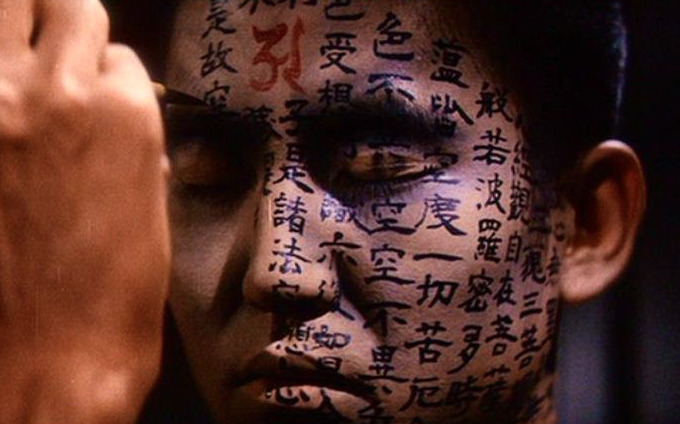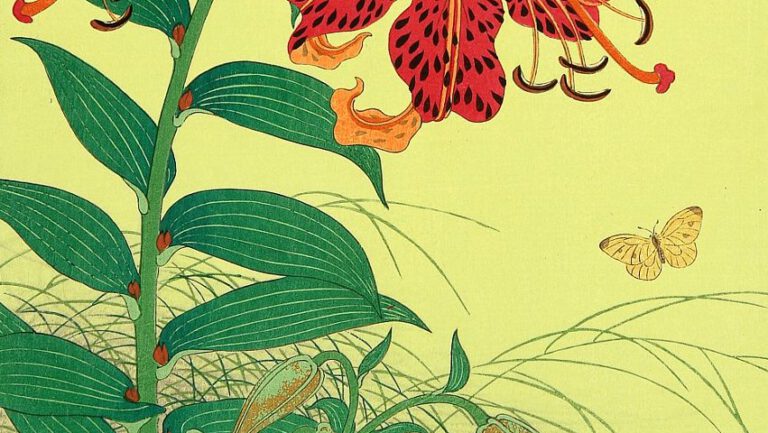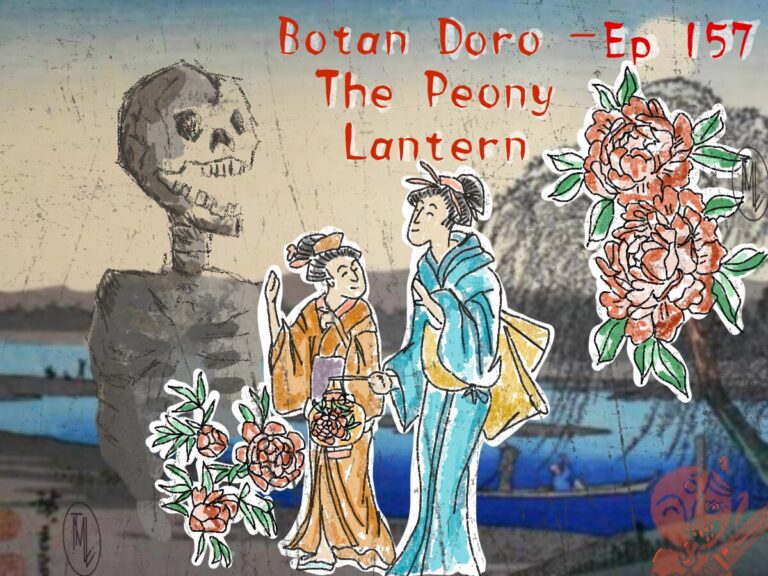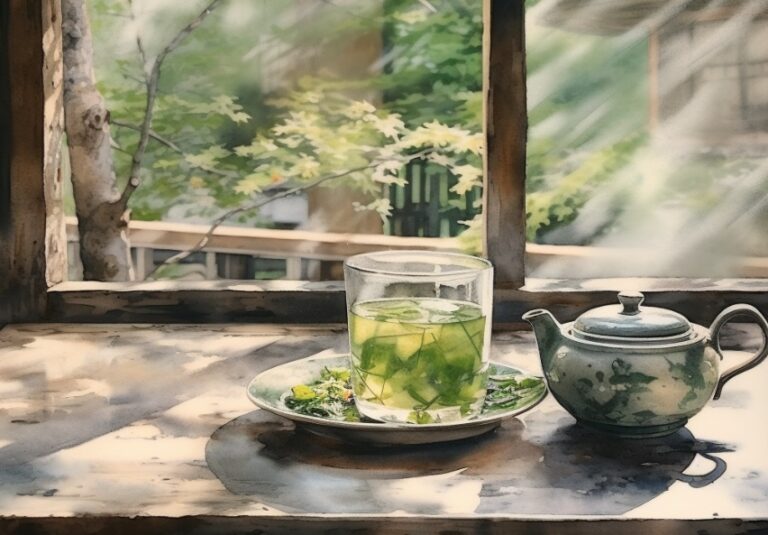Ever wonder why a jellyfish looks the way they do? Well, the Japanese folktale “The Jellyfish Takes a Journey” (Kurage no Honenashi) tells you how that came about. Then after that folktale, I’ll give you a little trivia about the connection between eel and seppuku.
You know what I haven’t done in awhile? A folktale. As a matter of fact, I just checked and the last time I did a real one, not one of my own stories or one of Lafcadio Hearn’s, was in October of 2018 when I retold “Kachi Kachi Mountain.” Remember the story about the jerk of a rabbit and the poor abused tanuki? Well, today I’m going to tell you another curious and, yeah, disturbing story, this time about the jellyfish. Jellyfish are called kurage in Japanese, and that is written by putting together the characters for ocean and moon. Ocean moon. Isn’t that beautiful?
Speaking of oceans, I’m literally recording this on July 23rd, Umi no Hi or Marine Day, sometimes called Ocean Day. Ocean, jellies. It’s kind of a theme.
*But it gets better. After the folktale about the jellyfish, I’m going to tell you a fascinating cultural nugget about eels and the act of seppuku, or ritual suicide. Eels are known to spend time in the ocean. So it’s another connection to Umi no Hi, Ocean Day.
*Speaking of oceans, after the story, I’ve got some really interesting trivia. It involves eels and seppuku, ritual suicide. Eels are known to spend time in the ocean. So that’s where that connects. Talk about through-line.
But before we get into why jellyfish look the way they do…
Intro
Hey hey, I hope everyone is hanging in there, not to stressed out about anything or everything. Maybe I can take your mind off of things, or perhaps damage you a little more. Have you ever wondered why jellyfish look the way they do? Well, there is an old folktale that goes by several titles:
“The Jellyfish Takes a Journey”, “The Jellyfish and the Monkey”, Or “Why the Jellyfish has no Bones” to name a few. In Japanese it’s sometimes called “Kurage no hone”, “Jellyfish Bones”, or “Kurage no hone nashi”, “No Jellyfish Bones”.
Lots of different titles and lots of different versions, even one by Yei Theodora Ozaki, what has retold a lot of Japanese folktales. But I decided to retell the one I found on the project Gutenberg site. It’s called “The Jellyfish Takes a Journey”, by Grace James.
The Project Gutenberg eBook, Japanese Fairy Tales, by Grace James, Illustrated by Warwick Goble
The Jelly-fish Takes a Journey
Once upon a time the jelly-fish was a very handsome fellow. His form was beautiful, and round as the full moon. He had glittering scales and fins and a tail as other fishes have, but he had more than these. He had little feet as well, so that he could walk upon the land as well as swim in the sea. He was merry and he was gay; he was beloved and trusted of the Dragon King. In spite of all this, his grandmother always said he would come to a bad end, because he would not mind his books at school. She was right. It all came about in this wise.
The Dragon King was but lately wed when the young Lady Dragon his wife fell very sick. She took to her bed and stayed there, and wise folk in Dragonland shook their heads and said her last day was at hand. Doctors came from far and near, and they dosed her and they bled her, but no good at all could they do her; the poor young thing, nor recover her of her sickness.
The Dragon King was beside himself.
“Heart’s Desire,” he said to his pale bride, “I would give my life for you.”
“Little good would it do me,” she answered. “Howbeit, if you will fetch me a monkey’s liver I will eat it and live.”
“A monkey’s liver!” cried the Dragon King. “A monkey’s liver! You talk wildly, O light of mine eyes. How shall I find a monkey’s liver? Know you not, sweet one, that monkeys dwell in the trees of the forest, whilst we are in the deep sea?”
Tears ran down the Dragon Queen’s lovely countenance.
“If I do not have the monkey’s liver, I shall die,” she said.
Then the Dragon went forth and called to him the jelly-fish.
“The Queen must have a monkey’s liver,” he said, “to cure her of her sickness.”
“What will she do with the monkey’s liver?” asked the jelly-fish.
“Why, she will eat it,” said the Dragon King.
“Oh!” said the jelly-fish.
“Now,” said the King, “you must go and fetch me a live monkey. I have heard that they dwell in the tall trees of the forest. Therefore swim quickly, O jelly-fish, and bring a monkey with you back again.”
“How will I get the monkey to come back with me?” said the jelly-fish.
“Tell him of all the beauties and pleasures of Dragonland. Tell him he will be happy here and that he may play with mermaids all the day long.”
“Well,” said the jelly-fish, “I’ll tell him that.”
Off set the jelly-fish; and he swam and he swam, till at last he reached the shore where grew the tall trees of the forest. And, sure enough, there was a monkey sitting in the branches of a persimmon tree, eating persimmons.
“The very thing,” said the jelly-fish to himself; “I’m in luck.”
“Noble monkey,” he said, “will you come to Dragonland with me?”
“How should I get there?” said the monkey.
“Only sit on my back,” said the jelly-fish, “and I’ll take you there; you’ll have no trouble at all.”
“Why should I go there, after all?” said the monkey. “I am very well off as I am.”
“Ah,” said the jelly-fish, “it’s plain that you know little of all the beauties and pleasures of Dragonland. There you will be happy as the day is long. You will win great riches and honour. Besides, you may play with the mermaids from morn till eve.”
“I’ll come,” said the monkey.
And he slipped down from the persimmon tree and jumped on the jelly-fish’s back.
When the two of them were about half-way over to Dragonland, the jelly-fish laughed.
“Now, jelly-fish, why do you laugh?”
“I laugh for joy,” said the jelly-fish. “When you come to Dragonland, my master, the Dragon King, will get your liver, and give it to my mistress the Dragon Queen to eat, and then she will recover from her sickness.”
“My liver?” said the monkey.
“Why, of course,” said the jelly-fish.
“Alas and alack,” cried the monkey, “I’m grieved indeed, but if it’s my liver you’re wanting I haven’t it with me. To tell you the truth, it weighs pretty heavy, so I just took it out and hung it upon a branch of that persimmon tree where you found me. Quick, quick, let’s go back for it.”
Back they went, and the monkey was up in the persimmon tree in a twinkling.
“Mercy me, I don’t see it at all,” he said. “Where can I have mislaid it? I should not be surprised if some rascal has stolen it,” he said.
Now if the jelly-fish had minded his books at school, would he have been hoodwinked by the monkey? You may believe not. But his grandmother always said he would come to a bad end.
“I shall be some time finding it,” said the monkey. “You’d best be getting home to Dragonland. The King would be loath for you to be out after dark. You can call for me another day. Sayonara.”
The monkey and the jelly-fish parted on the best of terms.
The minute the Dragon King set eyes on the jelly-fish, “Where’s the monkey?” he said.
“I’m to call for him another day,” said the jelly-fish. And he told all the tale.
The Dragon King flew into a towering rage. He called his executioners and bid them beat the jelly-fish.
“Break every bone in his body,” he cried; “beat him to a jelly.”
Alas for the sad fate of the jelly-fish! Jelly he remains to this very day.
As for the young Dragon Queen, she was fain to laugh when she heard the story.
“If I can’t have a monkey’s liver I must needs do without it,” she said. “Give me my best brocade gown and I will get up, for I feel a good deal better.”
The end.
Eel Trivia
Now onto my promised eel trivia.
Remember last episode we talked about unagi or eel? Well, I got a comment on Facebook the other day that jogged a very interesting memory about this slippery animal.
Way back in the day, a Japanese uncle who was very high up in an eel import company was always bringing some over because it was my favorite food at the time and he was a really nice guy.
Well, one day the family was all sitting around, dining on kabayaki (grilled eel), no less, and he was telling me about how eel are cleaned differently before cooking depending on the city. You might have heard of the Kansai and Kanto areas of Japan. In case you don’t know, Kansai is the western part, think Kyoto and Osaka; with Kanto being the eastern part, think Tokyo. There are a lot of customs, foods and traditions that are quite different between the Kansai and Kanto regions, but that’s a whole other topic.
For now, let’s concentrate on gutting your eel. In the Kanto region, Tokyo, remember that this was the old Edo Capital. There were a lot of samurai who worked under the Shogunate, and they didn’t like to be reminded of seppuku, or ritual suicide by cutting your stomach. Eel disembowelment is bad luck. Because of this when eel are prepared even to this day, they are readied by slicing along the backbone.
On the other hand, my uncle said, the Kansai region, which is known for being more outgoing, humorous, and friendly than their Eastern counterparts up in Kanto, and also were mostly merchants at the time, would clean the fish the usual way, by cutting the stomach. He then taught me the phrase, “hara wo watte hanasou”. Which literally means to break your stomach and talk. I think of it like, spilling your guts, or talking absolutely honestly about something. This is a good thing, so they have no problem with this way of gutting the eel.
My mind was blown. And I believed that until the other day a listener commented about it, jogged my memory, which made me do a little more research.
I’m sorry to say, there is something wrong with that analogy though. Something I never even considered until I spent an entire day reading up on how to clean and cook eel. Can you guess what it is?
Yes, eels were opened from the back, but all other fish were cleaned the usual way, cut from the stomach. So if people in the Kanto area really did hate the idea of being reminded about seppuku, why didn’t they cut all fish from the back?
The truth isn’t so much about seppuku, but more to do with the way the eel are cooked. I read some different reasons, but it seems that grilling eel started in the west, the Kansai area, where they prepared it the way they always prepared fish, by gutting the belly. It’s then grilled right away which makes the ell rich, more fragrant, but perhaps a little tough.
The technique then moved up to Edo and there they refined it. They learned that if you steam the eel first, then grilled it, it got rid of the fat and you ended up with a softer, plumper, and lighter fillet.
But why the different ways of cutting? I read and read and even in Japanese most of the sites talk about the seppuku and hara wo waru angle. But this is what I figured out, remember with the Kanto or Tokyo style the eel are steamed before grilled? Well, the cooks first skewer them with bamboo skewers and because of the way they’re steamed, cutting the eel from the back give a thicker edge for skewering, so that it doesn’t fall apart.
I want to thank Chris Garvey, who mentioned the seppuku angle over on Facebook and totally jogged my memory and made me dig a little deeper.
All that said, despite how much I used to love unagi, and how delicious they are, I haven’t eaten any in years. Many years. The poor little buggers are fast disappearing, their numbers plummeting. The Japanese Ministry of the Environment has even listed them as endangered. Though that doesn’t stop them from being stocked in supermarkets all over Japan.
Ganbare, unagi. Ganbare, kurage!
Thank you so very much for listening and supporting the show and I will talk to you again in two weeks.
Credits
Intro and outro music by Julyan Ray Matsuura
Medicine by WinnieTheMoog
Link: https://filmmusic.io/song/6256-medicine
License: http://creativecommons.org/licenses/by/4.0/
The Gates Of Heaven by MusicLFiles
Link: https://filmmusic.io/song/6341-the-gates-of-heaven
License: http://creativecommons.org/licenses/by/4.0/






